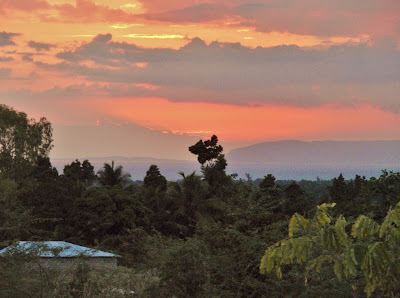Travay (Work)
Today and Monday have been very exhausting, but highly
productive days for the Gadyen Dlo project.
Yesterday, Santho and I walked around the neighboring communities and
tested various water sources for coliforms.
These are the bad bacteria found in water that indicate there is pollution present caused by some sort of
fecal contamination. Santho proved invaluable yet again because
he knew how to work the GPS device better than I did, he was our primary
photographer, and he opened and held all the little water vials for me—Oh, and
he was the only way I could communicate with everyone in these villages!
We
tested water from 5 main sources of water that people around the area use every
day for drinking (and cooking, bathing, and cleaning). First, we tested water from one of the pumps,
which only gets turned on three days a week for a select number of hours at a
time. Next, we tested the river water, a
little way upstream from where the canal system begins (see picture
above). Then we walked down the road,
through some banana fields and to a popular spot along the canal (below). Despite the lack of smiles from everyone but
me, these guys were all super friendly, laughing, and nice to me the whole time
we tested water there. A lot of Haitians
that I’ve met so far just don’t seem to like smiling for pictures—even though
they are enthusiastic about the photos.
Next, we walked across the dam and over to Do Digue, where
by some amazing good luck we ran into my little darling friend Islan, who
walked us the half mile or so up the river (and through it in some places)
where there is a little spring, and most people in Do Digue get there drinking
water. It was just the tiniest pool of
water, that I would never have noticed on my own, but it was pretty awesome to
see the water shooting up from the sand and rock bottom. The picture below is Santho, Islan, Islan’s
best friend (I feel terrible, but again, I cannot remember her name right now)
and I standing right above the spring.
And, yes, that’s a goat (“Kabrit!” the girls kept reminding me) on the
hill above us—they are roaming around EVERYWHERE.
Finally, we walked back down to the “coke” lady’s little shop (again, coca cola, but that’s just how we refer to this little tiny neighborhood spot to buy soft drinks) and bought a bag of water to test. All around the streets you can see litter from empty little water bags (they are slightly smaller than the sandwich sized ziplock baggies) that many people buy to drink—kind of like bottled water here in the States. The rest of the afternoon, we had more Gadyen Dlo new employee water training, which was also exhausting but productive.
.jpg)
Today, Santho and I spent the majority of our time in downtown Arcahaie, making color copies and laminating a variety of safe water visuals for the new Gadyen Dlo guys to take with them around their communities, and new badges for them to wear (I think they wanted to look even more “official” as they went around to various homes). I know that doesn’t seem like it should be so hard, but I assure you, the process of printing in color, making copies, and laminating these things took about 5 hours, 4 different shops, a taptap ride, and more money than you would think. But, I am extremely pleased with how successful we were ultimately! And, with all the time we spent waiting around for people to find supplies, and let machines cool down, etc., Santho and I had a series of very productive Kreyol lessons.




.jpg)
.jpg)

.jpg)
.jpg)
.jpg)
.jpg)

.jpg)


